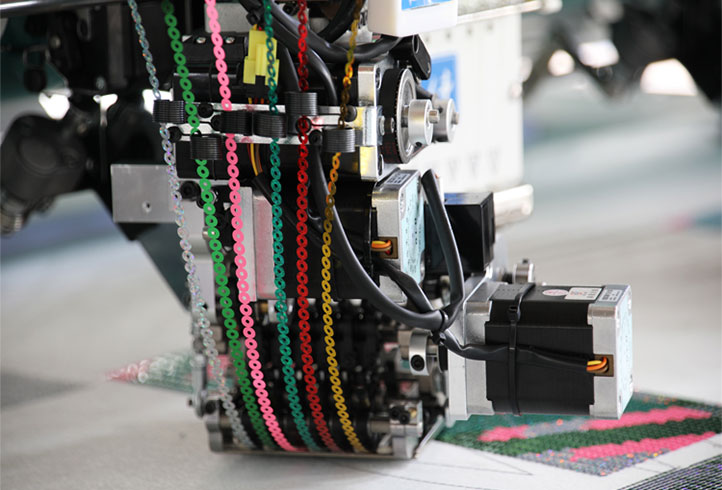Summary:When studying the application of color in clothing design, we must first understand some basic knowledge of color. Peopl...
When studying the application of color in clothing design, we must first understand some basic knowledge of color. People's sensitivity to color is far more than the sensitivity to shape, so the status of color in clothing design is crucial. Let's learn the color matching knowledge in computer embroidery.
Computerized embroidery thread color matching1. Basic knowledge of color The world of color is colorful, but it is not possible to express it through the combination of three basic colors, red, yellow, and blue. These three colors cannot be mixed with other colors, so they are called "primary colors". ". A color produced by the blending of two primary colors is called a "secondary color", such as red and yellow to make orange, yellow and cyan to make green. The combination of two "secondary colors" or primary colors and intermediate colors forms a complex color.
The ever-changing colors can be divided into two categories: chromatic and achromatic. All levels of gray, which are composed of black, white and black and white, belong to the achromatic system. White is the highest level of brightness, and black is the first level of brightness. All colors other than the achromatic family belong to the chromatic family. The color of the color system consists of three elements: hue, lightness, and purity.
Hue: The names of different colors are called hues, such as big red, lake blue, medium yellow, etc. Hue is the most important feature of a color. In the order of hues, they can be arranged in a hue circle. In the ever-changing world of colors, the vast difference in hue is the primary factor.
Brightness: It is an attribute of the change of light and shade of color, which is caused by the difference in the amount of light reflected by various colored objects.
Purity: Also known as chroma and saturation, it is the purity of a color including color. Red, orange, yellow, green, cyan, and violet obtained from spectral analysis are the pure colors of the scale. The higher the purity, the brighter and brighter the color.
 2. Colors and fashion design
2. Colors and fashion design People's reflections on colors are strong, but they are not all the same. Therefore, in the selection and matching of colors in clothing design, it is necessary to fully consider the spring and autumn, personality, self-cultivation, hobbies and temperament of different objects, and also take into account the different social, political, economic, cultural, artistic, custom and Under the influence of traditional living habits, people's different emotional reflections on color. For example, the dynasties of our country advocated yellow, thinking that yellow is a symbol of heaven and earth, giving yellow a majestic, luxurious and sacred association. In countries that believe in Christianity, yellow is considered to be the color of the costume of the traitor Judas, and it is a symbol of despicableness and shame. Therefore, the color design of clothing should be a targeted positioning design.
In design, the form of color matching and combination is directly related to the shaping of the overall style of clothing. Designers can use a group of contrasting color combinations with higher purity to express the passionate and unrestrained tropical style; they can also use a group of similar color combinations with lower chroma to reflect the elegant and simple style of clothing. The most commonly used color matching methods in clothing design are: : There are four types of color matching, similar color matching, contrasting color matching, and opposite color matching.
(1) Color matching of clothing of the same color: The matching of the same color is to match the color by unifying the different changes in the light and shade of one hue.
(2) Clothing color matching of similar colors: Similar color matching refers to the matching of colors within 90 degrees on the hue circle, giving people a sense of docility and coordination. Compared with the same color combination, the color sense is more varied, so its application range in clothing is wider than that of the same color combination.
(3) Clothing color matching of contrasting colors: The matching of contrasting colors refers to the color matching within the range of 120 degrees to 180 degrees on the hue circle, and the clothing style embodied is bright and lively, which is mostly used in the design of sportswear, children's clothes, and performance clothes.
(4) Clothing color matching of relative colors: relative color matching refers to the matching of two opposite colors at both ends of 180 degrees on the hue circle. In the color matching of relative colors, we should pay attention to the primary and secondary relationship, and at the same time, the contrast effect can be more interesting by adding intermediate colors.
3. Fashion colors and fashion design The fashion field has always advocated fashion awareness. The application of fashion colors in clothing is people's pursuit of fashionable colors, which reflects the aesthetic characteristics of modern life. Color is endowed with a bright sense of the times and fashion. With their sharp insights, color experts have summarized and refined the latest colors from the consumer market, and promoted them through forecasting. At present, the International Fashion Color Committee holds two regular meetings every year to guess the trend of popular colors in spring and autumn and winter in the coming year, and promote it through popular color cards, fashion magazines and textile samples and other media. In modern clothing design, popular colors are more widely used, and the combination of trendy styles and popular colors is becoming more and more intimate. Therefore, designers carefully analyze and study the law of fashion color cycle, grasp the fashion opportunity, and timely launch trendy clothing that meets people's aesthetic requirements in order to expand market sales.


